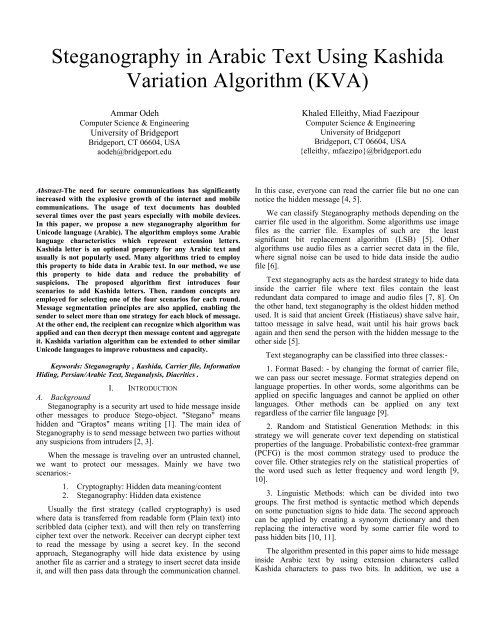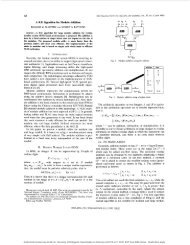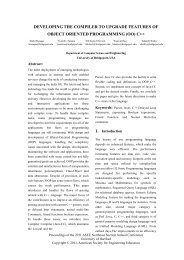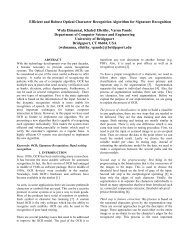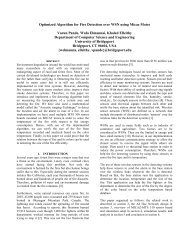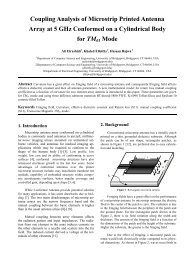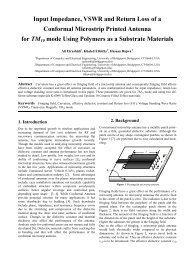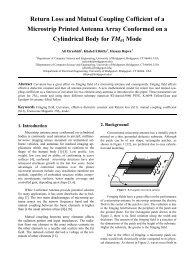Steganography in Arabic Text Using Kashida ... - ResearchGate
Steganography in Arabic Text Using Kashida ... - ResearchGate
Steganography in Arabic Text Using Kashida ... - ResearchGate
Create successful ePaper yourself
Turn your PDF publications into a flip-book with our unique Google optimized e-Paper software.
<strong>Steganography</strong> <strong>in</strong> <strong>Arabic</strong> <strong>Text</strong> Us<strong>in</strong>g <strong>Kashida</strong><br />
Variation Algorithm (KVA)<br />
Ammar Odeh<br />
Computer Science & Eng<strong>in</strong>eer<strong>in</strong>g<br />
University of Bridgeport<br />
Bridgeport, CT 06604, USA<br />
aodeh@bridgeport.edu<br />
Khaled Elleithy, Miad Faezipour<br />
Computer Science & Eng<strong>in</strong>eer<strong>in</strong>g<br />
University of Bridgeport<br />
Bridgeport, CT 06604, USA<br />
{elleithy, mfaezipo}@bridgeport.edu<br />
Abstract-The need for secure communications has significantly<br />
<strong>in</strong>creased with the explosive growth of the <strong>in</strong>ternet and mobile<br />
communications. The usage of text documents has doubled<br />
several times over the past years especially with mobile devices.<br />
In this paper, we propose a new steganography algorithm for<br />
Unicode language (<strong>Arabic</strong>). The algorithm employs some <strong>Arabic</strong><br />
language characteristics which represent extension letters.<br />
<strong>Kashida</strong> letter is an optional property for any <strong>Arabic</strong> text and<br />
usually is not popularly used. Many algorithms tried to employ<br />
this property to hide data <strong>in</strong> <strong>Arabic</strong> text. In our method, we use<br />
this property to hide data and reduce the probability of<br />
suspicions. The proposed algorithm first <strong>in</strong>troduces four<br />
scenarios to add <strong>Kashida</strong> letters. Then, random concepts are<br />
employed for select<strong>in</strong>g one of the four scenarios for each round.<br />
Message segmentation pr<strong>in</strong>ciples are also applied, enabl<strong>in</strong>g the<br />
sender to select more than one strategy for each block of message.<br />
At the other end, the recipient can recognize which algorithm was<br />
applied and can then decrypt then message content and aggregate<br />
it. <strong>Kashida</strong> variation algorithm can be extended to other similar<br />
Unicode languages to improve robustness and capacity.<br />
Keywords: <strong>Steganography</strong> , <strong>Kashida</strong>, Carrier file, Information<br />
Hid<strong>in</strong>g, Persian/<strong>Arabic</strong> <strong>Text</strong>, Steganalysis, Diacritics .<br />
I. INTRODUCTION<br />
A. Background<br />
<strong>Steganography</strong> is a security art used to hide message <strong>in</strong>side<br />
other messages to produce Stego-object. "Stegano" means<br />
hidden and “Graptos" means writ<strong>in</strong>g [1]. The ma<strong>in</strong> idea of<br />
<strong>Steganography</strong> is to send message between two parties without<br />
any suspicions from <strong>in</strong>truders [2, 3].<br />
When the message is travel<strong>in</strong>g over an untrusted channel,<br />
we want to protect our messages. Ma<strong>in</strong>ly we have two<br />
scenarios:-<br />
1. Cryptography: Hidden data mean<strong>in</strong>g/content<br />
2. <strong>Steganography</strong>: Hidden data existence<br />
Usually the first strategy (called cryptography) is used<br />
where data is transferred from readable form (Pla<strong>in</strong> text) <strong>in</strong>to<br />
scribbled data (cipher text), and will then rely on transferr<strong>in</strong>g<br />
cipher text over the network. Receiver can decrypt cipher text<br />
to read the message by us<strong>in</strong>g a secret key. In the second<br />
approach, <strong>Steganography</strong> will hide data existence by us<strong>in</strong>g<br />
another file as carrier and a strategy to <strong>in</strong>sert secret data <strong>in</strong>side<br />
it, and will then pass data through the communication channel.<br />
In this case, everyone can read the carrier file but no one can<br />
notice the hidden message [4, 5].<br />
We can classify <strong>Steganography</strong> methods depend<strong>in</strong>g on the<br />
carrier file used <strong>in</strong> the algorithm. Some algorithms use image<br />
files as the carrier file. Examples of such are the least<br />
significant bit replacement algorithm (LSB) [5]. Other<br />
algorithms use audio files as a carrier secret data <strong>in</strong> the file,<br />
where signal noise can be used to hide data <strong>in</strong>side the audio<br />
file [6].<br />
<strong>Text</strong> steganography acts as the hardest strategy to hide data<br />
<strong>in</strong>side the carrier file where text files conta<strong>in</strong> the least<br />
redundant data compared to image and audio files [7, 8]. On<br />
the other hand, text steganography is the oldest hidden method<br />
used. It is said that ancient Greek (Histiaeus) shave salve hair,<br />
tattoo message <strong>in</strong> salve head, wait until his hair grows back<br />
aga<strong>in</strong> and then send the person with the hidden message to the<br />
other side [5].<br />
<strong>Text</strong> steganography can be classified <strong>in</strong>to three classes:-<br />
1. Format Based: - by chang<strong>in</strong>g the format of carrier file,<br />
we can pass our secret message. Format strategies depend on<br />
language properties. In other words, some algorithms can be<br />
applied on specific languages and cannot be applied on other<br />
languages. Other methods can be applied on any text<br />
regardless of the carrier file language [9].<br />
2. Random and Statistical Generation Methods: <strong>in</strong> this<br />
strategy we will generate cover text depend<strong>in</strong>g on statistical<br />
properties of the language. Probabilistic context-free grammar<br />
(PCFG) is the most common strategy used to produce the<br />
cover file. Other strategies rely on the statistical properties of<br />
the word used such as letter frequency and word length [9,<br />
10].<br />
3. L<strong>in</strong>guistic Methods: which can be divided <strong>in</strong>to two<br />
groups. The first method is syntactic method which depends<br />
on some punctuation signs to hide data. The second approach<br />
can be applied by creat<strong>in</strong>g a synonym dictionary and then<br />
replac<strong>in</strong>g the <strong>in</strong>teractive word by some carrier file word to<br />
pass hidden bits [10, 11].<br />
The algorithm presented <strong>in</strong> this paper aims to hide message<br />
<strong>in</strong>side <strong>Arabic</strong> text by us<strong>in</strong>g extension characters called<br />
<strong>Kashida</strong> characters to pass two bits. In addition, we use a
andom algorithm to distribute the hidden bits <strong>in</strong>side the<br />
message.<br />
B. Ma<strong>in</strong> Contributions and Paper Organization<br />
A promis<strong>in</strong>g algorithm is presented <strong>in</strong> this paper. The ma<strong>in</strong><br />
idea is to use <strong>Kashida</strong> <strong>in</strong> <strong>Arabic</strong> that enables us to hide bits<br />
and remove any <strong>in</strong>truder suspicions. We first <strong>in</strong>troduce four<br />
scenarios to add <strong>Kashida</strong> letters and randomly select one of the<br />
four scenarios for each round. Message segmentation is<br />
applied, enabl<strong>in</strong>g the sender to select more than one strategy<br />
for each block of message. At the other end, the recipient can<br />
recognize which algorithm was applied and can then decrypt<br />
the message content and aggregate it.<br />
The rest of this paper is organized as follows. In Section II<br />
we discuss previous text <strong>Steganography</strong> techniques. <strong>Kashida</strong><br />
variation algorithm <strong>in</strong> <strong>Arabic</strong> hidden algorithm is discussed <strong>in</strong><br />
Section III. Section IV will describe our algorithm and provide<br />
analysis regard<strong>in</strong>g the proposed work. F<strong>in</strong>ally, conclud<strong>in</strong>g<br />
remarks are offered <strong>in</strong> Section V.<br />
<strong>Steganography</strong><br />
Protect Data<br />
Image<br />
Audio<br />
<strong>Text</strong><br />
Cryptography<br />
Symmeric<br />
Asymmertic<br />
Figure 1.Hidden Data classification<br />
II. PRIOR WORKS<br />
<strong>Text</strong> <strong>Steganography</strong> can be classified <strong>in</strong>to three strategies<br />
as shown <strong>in</strong> Figure 1. Each one of these techniques have<br />
advantages and drawbacks. In the follow<strong>in</strong>g section, we will<br />
present some of the prior works and provide some discussions<br />
on them.<br />
Different l<strong>in</strong>guistic methods have been classified <strong>in</strong>to two<br />
categories. The first one is syntax and the other one is<br />
semantic [9]. This work has been developed by creat<strong>in</strong>g a<br />
dictionary of synonyms, and creat<strong>in</strong>g a representation for each<br />
word by bit. Authors <strong>in</strong> [9] presented a novel synonym<br />
algorithm to hide data <strong>in</strong> Bahasa Melayu language, where the<br />
hidden algorithm is divided <strong>in</strong>to two phases. The first step<br />
converts hidden message <strong>in</strong>to b<strong>in</strong>ary codes by us<strong>in</strong>g ASCII<br />
codes. Then a synonyms file is created, where the sender and<br />
recipient must have the same word list to encrypt and decrypt<br />
the message. If the sender wants to <strong>in</strong>sert a Zero, then there is<br />
no need for word replacement. Otherwise, the word from<br />
synonyms file is replaced. The same strategy will be iterated<br />
until the end of the secret message is reached. The recipient<br />
can decrypt the message by an <strong>in</strong>vert<strong>in</strong>g strategy and<br />
compar<strong>in</strong>g if a replacement has occurred, <strong>in</strong> which case the<br />
secret code is 1.<br />
Other similar techniques have been presented <strong>in</strong> [12]. The<br />
algorithm consists of three <strong>in</strong>put sources; natural language;<br />
secret message and the key, and one output which is Stegoobject.<br />
By creat<strong>in</strong>g lexical substitutions set and variant forms<br />
of the same word, and after the first scan, the system will<br />
recognize each word and to which set it belongs to. The lexical<br />
analyzer for Ch<strong>in</strong>ese language is then used to embed the<br />
correct word <strong>in</strong> the carrier file and take the context <strong>in</strong>to<br />
consideration.<br />
L<strong>in</strong>e shift<strong>in</strong>g techniques have been presented <strong>in</strong> [13] by<br />
vertically shift<strong>in</strong>g the l<strong>in</strong>e. In some measurements , are<br />
employed so that secret data can be passed onto it. The ma<strong>in</strong><br />
drawback of this strategy is that character recognition<br />
programs can detect l<strong>in</strong>e shift<strong>in</strong>g. In addition, hidden data will<br />
be discarded by retyp<strong>in</strong>g the carrier document.<br />
Authors <strong>in</strong> [14] <strong>in</strong>troduced Syntactic methods us<strong>in</strong>g<br />
punctuations to pass the secret message by plac<strong>in</strong>g<br />
punctuations <strong>in</strong> proper positions to hide data. This method will<br />
not affect the mean<strong>in</strong>g of the message or the data embedded<br />
<strong>in</strong>side it. On other hand, little amount of data can be embedded<br />
by us<strong>in</strong>g this method.<br />
Authors <strong>in</strong> [12] employed one of the new technology<br />
techniques for Short Messag<strong>in</strong>g Service (SMS). The technique<br />
relies on us<strong>in</strong>g message abbreviation for words, and creat<strong>in</strong>g a<br />
table of abbreviation and description of the message, similar to<br />
Table I.<br />
TABLE I. SMS ABBREVIATION<br />
Abbreviation<br />
Description<br />
AFAIK<br />
As Far As I Know<br />
ABT<br />
About<br />
B4<br />
Before<br />
BTW<br />
By The Way<br />
EOL<br />
End of Lecture<br />
CRAP<br />
Cheap, redundant assorted<br />
products<br />
In [15], a novel text hid<strong>in</strong>g algorithm was proposed us<strong>in</strong>g<br />
chat properties; especially nowadays where chatt<strong>in</strong>g rooms are<br />
very popular. The ma<strong>in</strong> idea <strong>in</strong> this research was to use<br />
emoticons to hide data where tremendous number of those<br />
symbols could be used to hide data <strong>in</strong>side the file. Most of<br />
chat users use emoticons <strong>in</strong>stead words nowadays. So the first<br />
step of this algorithm is to classify symbols semantically and<br />
then control the symbol order by us<strong>in</strong>g a secret key. The work<br />
creates 4 sets of emoticons to hide data. As an example, if the<br />
symbol is <strong>in</strong>serted at the beg<strong>in</strong>n<strong>in</strong>g of sentence, it would pass<br />
0, otherwise the secret bit is 1. Other strategies used <strong>in</strong> this<br />
work rely on symbol order where data can be extracted from<br />
the symbol depend<strong>in</strong>g on the symbol order number <strong>in</strong> its set.<br />
For example, if it is <strong>in</strong> set 4 and order 3, the secret data is
0011, and so on. A lot of advantages can be acquired from<br />
this method, as chatt<strong>in</strong>g programs are so popular. Moreover,<br />
some chatt<strong>in</strong>g programs enable users to create their own<br />
customized symbols.<br />
New promis<strong>in</strong>g techniques were <strong>in</strong>troduced <strong>in</strong> [16] where<br />
one of the <strong>Arabic</strong> language properties called Diacritics<br />
(Harakat) was used. This is an optional property of the<br />
language. The idea was that if we want to pass 1 we keep that<br />
Harakat, otherwise we remove it to pass zero.<br />
In [17], the authors presented a new text steganography<br />
technique for <strong>Arabic</strong> language aga<strong>in</strong> by us<strong>in</strong>g one of <strong>Arabic</strong><br />
characteristics; diacritics or Harakat. Usually, Haraka<br />
represent vowel sounds. Nowadays it’s rarely to used, but on<br />
other hand any religious document must have it. <strong>Arabic</strong><br />
language has 8 Diacritics where the most frequently used one<br />
is Fatha. The work uses Fatha to represent one and 0 can be<br />
represented by any of the rema<strong>in</strong><strong>in</strong>g seven. In this case, 1 is<br />
the hidden bit, where the first Fatha can be found and any<br />
other Haraka before it can be removed to hide 1. One of the<br />
advantages of this method is the reusability feature where the<br />
same cover can be used for more than one hidden message.<br />
Moreover, this technique does not require complex software.<br />
On other hand, however, Harakat are rarely used nowadays.<br />
In [18] the authors <strong>in</strong>troduced a new algorithm us<strong>in</strong>g some<br />
, ف, ( letters of the <strong>Arabic</strong> letters which are called po<strong>in</strong>ted<br />
) by vertical shift<strong>in</strong>g of the po<strong>in</strong>t(s). If we want ظ خ , ت , , ض<br />
to pass a Zero, no vertical shift takes place, otherwise we pass<br />
one by vertical shift<strong>in</strong>g. The work <strong>in</strong> [19] improves the<br />
vertical po<strong>in</strong>t shift<strong>in</strong>g method by us<strong>in</strong>g multipo<strong>in</strong>t characters<br />
only and tak<strong>in</strong>g <strong>in</strong>to account the shift<strong>in</strong>g and distance between<br />
po<strong>in</strong>ts to pass two bits <strong>in</strong> each multipo<strong>in</strong>t letter.<br />
غ, ن<br />
ث<br />
III.<br />
PROPOSED ALGORITHM<br />
Some of the <strong>Arabic</strong> characters features support different<br />
<strong>Steganography</strong> algorithms. In the follow<strong>in</strong>g section, we<br />
explore some <strong>Arabic</strong> language properties to use some of its<br />
attributes to hide large amount of data <strong>in</strong>side Unicode file<br />
(<strong>Arabic</strong> language).<br />
1. Writ<strong>in</strong>g Direction:-<br />
<strong>Arabic</strong> text is written from right to left. It is a<br />
unidirectional language and numbers are read and written <strong>in</strong><br />
the same direction.<br />
2. Letter connectivity:-<br />
Most of the <strong>Arabic</strong> letters <strong>in</strong> the word are connected with<br />
the previous letter and next one. Therefore, the letter may have<br />
different shapes depend<strong>in</strong>g on its position <strong>in</strong> the word as<br />
shown <strong>in</strong> Figure 2.<br />
Figure 2. Different (Mem) Letter shapes depend<strong>in</strong>g on its position<br />
<strong>in</strong> the word.<br />
3. Dotted letters:-<br />
Some <strong>Arabic</strong> letters have one, two and sometimes three<br />
po<strong>in</strong>ts. These po<strong>in</strong>ts affect the letter’s pronunciation [20] as<br />
shown <strong>in</strong> Table II.<br />
4. <strong>Kashida</strong> letter:-<br />
One of <strong>Arabic</strong> language characteristic is to extend the<br />
() letter, which is called <strong>Kashida</strong> letter. This is represented as<br />
after jo<strong>in</strong><strong>in</strong>g the letter. For example ,(احمد) can be written as (<br />
) where we add two <strong>Kashida</strong>. This means that we can احمد<br />
embed 2 bits <strong>in</strong>side one word.<br />
Letter<br />
TABLE II. ARABIC LETTERS<br />
Number of po<strong>in</strong>ts<br />
0 و,ه,ل,ك,ع,ط,ص,ر,د,ح,ا<br />
1 ن,ف,غ,ظ,ض,ز,ذ,خ,ج,ب<br />
2 ي,ق,ت<br />
3 ش,ث<br />
Therefore, if we have any word which consists of N<br />
connected letters we can embed N-1 bits <strong>in</strong>side it. If our text<br />
conta<strong>in</strong>s J words that conta<strong>in</strong> connective letters, the number of<br />
embedded bits is:<br />
Embedded = (N-1)× J; (1)<br />
In our algorithm, we exploit this property <strong>in</strong> <strong>Arabic</strong> text to<br />
hide data <strong>in</strong>side cover media. In addition, we apply four<br />
scenarios randomly to improve data privacy. This is while<br />
most of the previous algorithms apply the same procedure for<br />
the whole text, <strong>in</strong> which case they may allow Stegoanalysis to<br />
follow up the text format, which may lead to break<strong>in</strong>g the<br />
hid<strong>in</strong>g algorithm.<br />
Our proposed algorithm has four scenarios as follows:<br />
Scenario 0:- Add<strong>in</strong>g <strong>Kashida</strong> after po<strong>in</strong>ted letters to encode<br />
one, otherwise, we pass zero.<br />
Scenario 1:- Add<strong>in</strong>g <strong>Kashida</strong> after non-po<strong>in</strong>ted letters to<br />
encode one, otherwise, we pass zero.<br />
Scenario 2:- Add<strong>in</strong>g <strong>Kashida</strong> after letters to encode one,<br />
otherwise, we pass zero.<br />
Scenario 3:- Add<strong>in</strong>g <strong>Kashida</strong> after letters to encode zero,<br />
otherwise, we pass one.<br />
Therefore, we will randomly use these scenarios to hide<br />
data. At the beg<strong>in</strong>n<strong>in</strong>g, we will divide the text <strong>in</strong>to blocks as<br />
shown <strong>in</strong> Figure 3. Each block will pick up a scenario from the<br />
suggested scenarios above.<br />
Algorithm I: Segmentation and Aggregation<br />
Input Message<br />
Segment Message <strong>in</strong>to Blocks (Block 0, Block 1 ….Block N)<br />
For I=0 TO N<br />
Rand_Number = Rand() % 4 // module of number (0,1,2,3)<br />
Switch (Rand_Number)<br />
{
Case 0: call Scenario_0(Block I); Break;<br />
Case 1: call Scenario_1(Block I); Break;<br />
Case 2: call Scenario_2(Block I); Break;<br />
Case 3: call Scenario_3(Block I); Break;<br />
}<br />
Insert encrypted (Block I) to Stego message<br />
Next I<br />
Output Stego message<br />
Rout<strong>in</strong>e Scenario_0(Block I) // Add<strong>in</strong>g <strong>Kashida</strong> after po<strong>in</strong>ted<br />
letters to encode one, otherwise, zero.<br />
While Not_End_Block<br />
Read letter<br />
If letter connected then // we can add <strong>Kashida</strong><br />
{<br />
If (Hide bit==1) then<br />
Add <strong>Kashida</strong><br />
Replace (Letter)<br />
Else<br />
No_change<br />
}<br />
Next Letter<br />
End while<br />
End Rout<strong>in</strong>e Scenario_0<br />
a word. This is while other algorithms such as [9] can pass<br />
only one bit per word.<br />
I. Our algorithm can be applied <strong>in</strong> different file formats like<br />
HTML files, and MS word files. This will also will reduce<br />
<strong>in</strong>truder suspicions.<br />
II.<br />
III.<br />
Another advantage is that there is no need to create a<br />
database dictionary like [15] where search<strong>in</strong>g for<br />
synonyms words will consume some time, and may give<br />
<strong>in</strong>truders a chance to analyze the transmitted files.<br />
Randomization of our algorithm will improve robustness of<br />
hidden data, s<strong>in</strong>ce <strong>in</strong> each round, the algorithm will pack<br />
up one of four states and this will prevent the <strong>in</strong>truder to<br />
figure out the algorithm procedure.<br />
IV. Our algorithm can be extended to other similar Unicode<br />
languages like Urdu, Pashto, and Persian. Moreover our<br />
algorithm can be widely used, as Urdu and <strong>Arabic</strong><br />
represent the 3 rd and 4 th top languages population [21].<br />
V. By employ<strong>in</strong>g <strong>Kashida</strong> variation algorithm, unlike [9] the<br />
text semantic will not be changed.<br />
Figure 3. Message segmentation and aggregation<br />
IV.<br />
ALGORITHM ANALYSIS AND ADVANTAGES<br />
In our algorithm, we used variation and randomization to<br />
improve <strong>Kashida</strong> algorithm to hide data <strong>in</strong>side Unicode<br />
(<strong>Arabic</strong> language). In the follow<strong>in</strong>g section, we explore and<br />
analytically discuss some of the advantages of the proposed<br />
algorithm.<br />
Hid<strong>in</strong>g capacity, transparency, and robustness represent the<br />
most important goals for any <strong>Steganography</strong> algorithm. In our<br />
algorithm, we achieve the follow<strong>in</strong>g advantages:-By us<strong>in</strong>g the<br />
<strong>Kashida</strong> variation algorithm, we can pass more than one bit for<br />
Figure 4.Rout<strong>in</strong>e Scenario_0 flow chart<br />
V. EXPERIMENTS AND RESULTS<br />
In this section, we explore some of the results acquired by<br />
apply<strong>in</strong>g our algorithm and consider<strong>in</strong>g the concept of hidden<br />
ratio.<br />
Hidden ratio is def<strong>in</strong>ed as:<br />
Hidden Ratio=amount of hidden data/carrier file size (1)
Table III shows the result of four scenarios suggested by<br />
the KVA algorithm and the position of data hidden <strong>in</strong>side it.<br />
TABLE III. APPLIED SCENARIOS TO MEASURE HIDDEN RATIO<br />
Applied Scenario Hidden Bits Stego Object<br />
Scenario1 0100<br />
Scenario2 1011<br />
Scenario3 11000100<br />
Scenario4 001011100<br />
اتق شر من احسنت<br />
اليه<br />
اتق شر من احسنت<br />
اليه<br />
اتق شر من احسنت<br />
اليه<br />
اتق شر من احسنت<br />
اليه<br />
”اتق شر من احسنت اليه“ Table III shows an <strong>Arabic</strong> sentence<br />
and the four suggested scenarios applied on it. Each scenario<br />
used <strong>Kashida</strong> (shift +J) to hide data depend<strong>in</strong>g on the position<br />
of the extension letter. So the semantic of the Stego-Object is<br />
the same and this avoids any suspicion from attackers. As<br />
shown <strong>in</strong> the Table, each scenario has a different hidden ratio,<br />
as add<strong>in</strong>g <strong>Kashida</strong> characters depend on the <strong>in</strong>serted position.<br />
Hence the first two scenarios have less hidden data ratio<br />
compared to the last two. On average, the number of hidden<br />
data rate is six bits <strong>in</strong> the above message. So, depend<strong>in</strong>g on the<br />
experiments, <strong>in</strong>sert<strong>in</strong>g bits <strong>in</strong>side the message has three<br />
performance cases. The best case performance is as shown <strong>in</strong><br />
scenario 3, while scenario 4 provides the worst case, and<br />
scenarios 1and 2 offer average case performance.<br />
Table IV represents hidden data ratio and a comparison<br />
between our proposed algorithm and the word and l<strong>in</strong>e shift<strong>in</strong>g<br />
algorithms.<br />
TABLE IV. HIDDEN DATA RATIO<br />
Web Website KVA<br />
L<strong>in</strong>e Word<br />
Shift shift<br />
1 www.aljazeera.net 34.5 0.20 2.87<br />
2 www.bbc.co.uk 30.8 0.21 2.06<br />
3 www.ahram.org.eg 35.5 0.23 2.96<br />
4 www.addustour.com 41.2 0.32 2.75<br />
Figure 5. Hidden ratio<br />
VI.<br />
CONCLUSION<br />
Hid<strong>in</strong>g data <strong>in</strong> different cover media represents one of the<br />
challeng<strong>in</strong>g security issues. One of the challeng<strong>in</strong>g media for<br />
hid<strong>in</strong>g data is text, where embedd<strong>in</strong>g data may affect the text<br />
format, file size and format. File Changes will <strong>in</strong>crease the<br />
probability of be<strong>in</strong>g discovered us<strong>in</strong>g Stegoanalysis tools and<br />
this will lead to reveal<strong>in</strong>g the hidden data. The strategy<br />
presented <strong>in</strong> this paper employed two concepts to improve<br />
transparency, robustness and hid<strong>in</strong>g capacity by us<strong>in</strong>g the<br />
extension of <strong>Arabic</strong> language characters, called <strong>Kashida</strong>.<br />
Selection among different four scenarios <strong>in</strong>creases the<br />
algorithm complexity, and also reduces the likelihood of be<strong>in</strong>g<br />
suspicions. In addition, this algorithm can be applied on<br />
different Unicode languages like Persian, Pashto, and Urdu,<br />
where nearly 2 billion of the world population can benefit<br />
from KVA.<br />
REFERENCES<br />
[1] N. F. Johnson and S. Jajodia, "Explor<strong>in</strong>g<br />
steganography: See<strong>in</strong>g the unseen," IEEE computer,<br />
vol. 31, pp. 26-34, 1998.<br />
[2] A. Mangarae, "<strong>Steganography</strong> FAQ," Zone-H.org,<br />
2006.<br />
[3] S. Dickman, "An Overview of <strong>Steganography</strong>,"<br />
James Madison University Infosec Techreport,<br />
Department of Computer Science, JMU-INFOSEC-<br />
TR-2007-002<br />
(http://www.<strong>in</strong>fosec.jmu.<br />
edu/reports/jmu-<strong>in</strong>fosec-tr-2007-002. pdf), 2007.<br />
[4] S. Changder, D. Ghosh, and N. Debnath, "L<strong>in</strong>guistic<br />
approach for text steganography through Indian text,"<br />
<strong>in</strong> Computer Technology and Development (ICCTD),<br />
2010 2nd International Conference on, 2010, pp.<br />
318-322.<br />
[5] T. Morkel, J. H. P. Eloff, and M. S. Olivier, "An<br />
overview of image steganography," <strong>in</strong> Proceed<strong>in</strong>gs of<br />
the Fifth Annual Information Security South Africa<br />
Conference (ISSA2005), Sandton, South Africa, 2005.<br />
[6] M. A. F. Al-Husa<strong>in</strong>y, "Image <strong>Steganography</strong> by<br />
mapp<strong>in</strong>g Pixels to letters," Journal of Computer<br />
science, vol. 5, pp. 33-38, 2009.<br />
[7] V. Potdar and E. Chang, "Visibly Invisible:<br />
Ciphertext as a Steganographic Carrier," <strong>in</strong><br />
Proceed<strong>in</strong>gs of the 4th International Network<br />
Conference (INC2004), 2004, pp. 385-391.<br />
[8] S. Bhattacharyya, I. Banerjee, and G. Sanyal, "A<br />
novel approach of secure text based steganography<br />
model us<strong>in</strong>g word mapp<strong>in</strong>g method (WMM),"<br />
Journal on “International Journal of Computer and<br />
Information Eng<strong>in</strong>eer<strong>in</strong>g, vol. 4, p. 2, 2010.<br />
[9] R. Prasad and K. Alla, "A new approach to Telugu<br />
text steganography," <strong>in</strong> IEEE Symposium on Wireless<br />
Technology and Applications (ISWTA), 2011, pp. 60-<br />
65.<br />
[10] V. N. Rao and D. D. Shulman, Classical Telugu<br />
poetry: an anthology: University of California Press,<br />
2002.
[11] K. Bennett, "L<strong>in</strong>guistic steganography: Survey,<br />
analysis, and robustness concerns for hid<strong>in</strong>g<br />
<strong>in</strong>formation <strong>in</strong> text," CERIAS Tech Report p. 28,<br />
2004.<br />
[12] L. Yul<strong>in</strong>g, S. X<strong>in</strong>gm<strong>in</strong>g, G. Can, and W. Hong, "An<br />
efficient l<strong>in</strong>guistic steganography for Ch<strong>in</strong>ese text,"<br />
<strong>in</strong> IEEE International Conference on Multimedia and<br />
Expo, 2007, pp. 2094-2097.<br />
[13] S. H. Low, N. F. Maxemchuk, J. Brassil, and L.<br />
O'Gorman, "Document mark<strong>in</strong>g and identification<br />
us<strong>in</strong>g both l<strong>in</strong>e and word shift<strong>in</strong>g," <strong>in</strong> Proceed<strong>in</strong>gs of<br />
the Fourteenth Annual Jo<strong>in</strong>t Conference of the IEEE<br />
Computer and Communications Societies. Br<strong>in</strong>g<strong>in</strong>g<br />
Information to People, IEEE INFOCOM'9., 1995, pp.<br />
853-860.<br />
[14] W. Bender, D. Gruhl, N. Morimoto, and A. Lu,<br />
"Techniques for data hid<strong>in</strong>g," IBM systems journal,<br />
vol. 35, pp. 313-336, 1996.<br />
[15] Z. H. Wang, C. C. Chang, and M. C. Li, "Emoticonbased<br />
text steganography <strong>in</strong> chat," <strong>in</strong> Asia-Pacific<br />
Conference on Computational Intelligence and<br />
Industrial Applications, 2009. PACIIA, 2009, pp.<br />
457-460.<br />
[16] M. L. Bensaad and M. B. Yagoubi, "High capacity<br />
diacritics-based method for <strong>in</strong>formation hid<strong>in</strong>g <strong>in</strong><br />
<strong>Arabic</strong> text," <strong>in</strong> International Conference on<br />
Innovations <strong>in</strong> Information Technology (IIT), 2011,<br />
pp. 433-436.<br />
[17] M. A. Aabed, S. M. Awaideh, A. R. M. Elshafei, and<br />
A. A. Gutub, "<strong>Arabic</strong> diacritics based<br />
steganography," <strong>in</strong> IEEE International Conference on<br />
Signal Process<strong>in</strong>g and Communications, ICSPC,<br />
2007, pp. 756-759.<br />
[18] M. H. Shirali-Shahreza and M. Shirali-Shahreza, "A<br />
new approach to Persian/<strong>Arabic</strong> text steganography,"<br />
<strong>in</strong> 1st and 5th IEEE/ACIS International Workshop on<br />
Component-Based Software Eng<strong>in</strong>eer<strong>in</strong>g, Software<br />
Architecture and Reuse Computer and Information<br />
Science, ICIS-COMSAR and IEEE/ACIS, 2006, pp.<br />
310-315.<br />
[19] A. Odeh, A. Alzubi, Q. B. Hani, and K. Elleithy,<br />
"<strong>Steganography</strong> by multipo<strong>in</strong>t <strong>Arabic</strong> letters," <strong>in</strong><br />
IEEE Long Island Systems, Applications and<br />
Technology Conference (LISAT), 2012, pp. 1-7.<br />
[20] A. Azmi and A. Alsaiari, "<strong>Arabic</strong> Typography: A<br />
Survey," International Journal of Electrical &<br />
Computer Sciences, vol. 9, pp. 16-22, 2010.<br />
[21] M. Turner, "The world’s most widely spoken<br />
languages," ed: St. Ignatius High School. URL:<br />
http://www2.ignatius.edu/faculty/turner/languages.<br />
htm [viewed December 10, 2003], 2003.<br />
Ammar Odeh is a PhD. Student <strong>in</strong> University of Bridgeport.<br />
He earned the M.S. degree <strong>in</strong> Computer Science College of<br />
K<strong>in</strong>g Abdullah II School for Information Technology<br />
(KASIT) at the University of Jordan <strong>in</strong> Dec. 2005 and the<br />
B.Sc. <strong>in</strong> Computer Science from the Hashemite University. He<br />
has worked as a Lab Supervisor <strong>in</strong> Philadelphia University<br />
(Jordan) and Lecturer <strong>in</strong> Philadelphia University for the ICDL<br />
Courses and as technical support for onl<strong>in</strong>e exam<strong>in</strong>ations for<br />
two years. He served as a Lecturer at the IT, (ACS,CIS ,CS)<br />
Department of Philadelphia University <strong>in</strong> Jordan, and also<br />
worked at the M<strong>in</strong>istry of Higher Education (Oman, Sur<br />
College of Applied Science) for two years. Ammar jo<strong>in</strong>ed the<br />
University of Bridgeport as a PhD student of Computer<br />
Science and Eng<strong>in</strong>eer<strong>in</strong>g <strong>in</strong> August 2011. His area of<br />
concentration is reverse software eng<strong>in</strong>eer<strong>in</strong>g, computer<br />
security, and wireless networks. Specifically, he is work<strong>in</strong>g on<br />
the enhancement of computer security for data transmission<br />
over wireless networks. He is also actively <strong>in</strong>volved <strong>in</strong><br />
academic community, outreach activities and student<br />
recruit<strong>in</strong>g and advis<strong>in</strong>g.<br />
Dr. Khaled Elleithy is the Associate Dean for Graduate<br />
Studies <strong>in</strong> the School of Eng<strong>in</strong>eer<strong>in</strong>g at the University of<br />
Bridgeport. He has research <strong>in</strong>terests are <strong>in</strong> the areas of<br />
network security, mobile communications, and formal<br />
approaches for design and verification. He has published more<br />
than two hundred research papers <strong>in</strong> <strong>in</strong>ternational journals and<br />
conferences <strong>in</strong> his areas of expertise. Dr. Elleithy is the cochair<br />
of the International Jo<strong>in</strong>t Conferences on Computer,<br />
Information, and Systems Sciences, and Eng<strong>in</strong>eer<strong>in</strong>g (CISSE).<br />
CISSE is the first Eng<strong>in</strong>eer<strong>in</strong>g/Comput<strong>in</strong>g and Systems<br />
Research E-Conference <strong>in</strong> the world to be completely<br />
conducted onl<strong>in</strong>e <strong>in</strong> real-time via the <strong>in</strong>ternet and was<br />
successfully runn<strong>in</strong>g for six years. Dr. Elleithy is the editor or<br />
co-editor of 12 books published by Spr<strong>in</strong>ger for advances on<br />
Innovations and Advanced Techniques <strong>in</strong> Systems, Comput<strong>in</strong>g<br />
Sciences and Software.<br />
Dr. Miad Faezipour is an Assistant Professor <strong>in</strong> the<br />
Computer Science and Eng<strong>in</strong>eer<strong>in</strong>g program at the University<br />
of Bridgeport and the director of the Digital/Biomedical<br />
Embedded Systems & Technology (D-BEST) Lab s<strong>in</strong>ce July<br />
2011. Prior to jo<strong>in</strong><strong>in</strong>g UB, she has been a Post-Doctoral<br />
Research Associate at the University of Texas at Dallas<br />
collaborat<strong>in</strong>g with the Center for Integrated Circuits and<br />
Systems and the Quality of Life Technology laboratories. She<br />
received the B.Sc. <strong>in</strong> Electrical Eng<strong>in</strong>eer<strong>in</strong>g from the<br />
University of Tehran, Tehran, Iran and the M.Sc. and Ph.D. <strong>in</strong><br />
Electrical Eng<strong>in</strong>eer<strong>in</strong>g from the University of Texas at Dallas.<br />
Her research <strong>in</strong>terests lie <strong>in</strong> the broad area of biomedical<br />
signal process<strong>in</strong>g and behavior analysis techniques, highspeed<br />
packet process<strong>in</strong>g architectures, and digital/embedded<br />
systems. Dr. Faezipour is a member of IEEE, EMBS and IEEE<br />
women <strong>in</strong> eng<strong>in</strong>eer<strong>in</strong>g.


